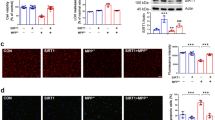Abstract
Sestrin-2 (SESN2) is a conserved antioxidant protein that is activated upon oxidative stress and protects cells against reactive oxygen species (ROS). However, the role of SESN2 in neurodegenerative diseases, especially in Parkinson’s disease (PD), has not yet been elucidated. In this study, we found that expression of SESN2 is elevated in the midbrain of patients with PD. Moreover, in vitro experiments display that the drug 1-methyl-4-phenylpyridinium (MPP+) induces the expression of SESN2 in SH-SY5Y cells in a time- and dose-dependent manner. Our results show that p53 is activated by MPP+. Importantly, inhibition of p53 using small RNA interferences abolishes the increased SESN2 levels induced by MPP+, suggesting that the inductive effect of MPP+ on SESN2 is mediated by p53. Furthermore, knockdown of SESN2 using small RNA interferences promotes MPP+-related neurotoxicity by attenuating oxidative stress, mitochondrial dysfunction, and apoptosis. All these data imply that the induction of SESN2 produces a protective effect in PD.







Similar content being viewed by others
References
Alves da Costa C, Checler F (2011) Apoptosis in Parkinson’s disease: is p53 the missing link between genetic and sporadic Parkinsonism? Cell Signal 23(6):963–968
Bove J, Perier C (2012) Neurotoxin-based models of Parkinson’s disease. Neuroscience 211:51–76
Budanov AV, Karin M (2008) p53 target genes sestrin1 and sestrin2 connect genotoxic stress and mTOR signaling. Cell 134:451–460
Budanov AV, Shoshani T, Faerman A et al (2002) Identification of a novel stress-responsive gene Hi95 involved in regulation of cell viability. Oncogene 21:6017–6031
Budanov AV, Sablina AA, Feinstein E, Koonin EV, Chumakov PM (2004) Regeneration of peroxiredoxins by p53-regulated sestrins, homologs of bacterial AhpD. Science 304:596–600
Dauer W, Przedborski S (2003) Parkinson’s disease: mechanisms and models. Neuron 39:889–909
Duan W, Zhu X, Ladenheim B et al (2002) p53 inhibitors preserve dopamine neurons and motor function in experimental parkinsonism. Ann Neurol 52:597–606
Essler S, Dehne N, Brüne B (2009) Role of sestrin2 in peroxide signaling in macrophages. FEBS Lett 583:3531–3535
Exner N, Lutz AK, Haass C, Winklhofer KF (2012) Mitochondrial dysfunction in Parkinson’s disease: molecular mechanisms and pathophysiological consequences. EMBO J 31(14):3038–3062
Giordano S, Lee J, Darley-Usmar VM, Zhang J (2012) Distinct effects of rotenone, 1-methyl-4-phenylpyridinium and 6-hydroxydopamine on cellular bioenergetics and cell death. PLoS One 7(9):e44610
Jackson-Lewis V, Przedborski S (2007) Protocol for the MPTP mouse model of Parkinson’s disease. Nat Protoc 2(1):141–151
Kim JR, Lee SR, Chung HJ et al (2003) Identification of amyloid β-peptide responsive genes by cDNA microarray technology: involvement of RTP801 in amyloid β-peptide toxicity. Exp Mol Med 35:403–411
Kopin IJ, Markey SP (1988) MPTP toxicity: implications for research in Parkinson’s disease. Annu Rev Neurosci 11:81–96
Lee JH, Budanov AV, Park EJ, Birse R, Kim TE et al (2010) Sestrin as a feedback inhibitor of TOR that prevents age-related pathologies. Science 327:1223–1228
Liu SY, Lee YJ, Lee TC (2011) Association of platelet-derived growth factor receptor β accumulation with increased oxidative stress and cellular injury in sestrin 2 silenced human glioblastoma cells. FEBS Lett 585(12):1853–1858
Maiuri MC, Malik SA, Morselli E et al (2009) Stimulation of autophagy by the p53 target gene Sestrin2. Cell Cycle 8:1571–1576
Nicklas WJ, Vyas I, Heikkila RE (1985) Inhibition of NADH-linked oxidation in brain mitochondria by 1-methyl-4-phenyl-pyridine, a metabolite of the neurotoxin, 1-methyl-4-phenyl-1,2,5,6-tetrahydropyridine. Life Sci 36:2503–2508
Papadia S, Soriano FX, Léveillé F et al (2008) Synaptic NMDA receptor activity boosts intrinsic antioxidant defenses. Nat Neurosci 11(4):476–487
Soontornniyomkij V, Soontornniyomkij B, Moore DJ et al (2012) Antioxidant sestrin-2 redistribution to neuronal soma in human immunodeficiency virus-associated neurocognitive disorders. J Neuroimmune Pharmacol 7:579–590
Tobón-Velasco JC, Carmona-Aparicio L, Ali SF, Santamaría A (2010) Biomarkers of cell damage induced by oxidative stress in Parkinson’s disease and related models. Cent Nerv Syst Agents Med Chem 10(4):278–286
Vyas I, Heikkila RE, Nicklas WJ (1986) Studies on the neurotoxicity of 1-methyl-4-phenyl-1,2,3,6-tetrahydropyridine: inhibition of NAD-linked substrate oxidation by its metabolite, 1-methyl-4-phenylpyridinium. J Neurochem 46:1501–1507
Zhuang J, Ma W, Lago CU, Hwang PM (2012) Metabolic regulation of oxygen and redox homeostasis by p53: lessons from evolutionary biology? Free Radic Biol Med 53(6):1279–1285
Author information
Authors and Affiliations
Corresponding author
Rights and permissions
About this article
Cite this article
Daixing, Z., Chengye, Z., Qiang, Z. et al. Upregulation of Sestrin-2 Expression via P53 Protects Against 1-Methyl-4-Phenylpyridinium (MPP+) Neurotoxicity. J Mol Neurosci 51, 967–975 (2013). https://doi.org/10.1007/s12031-013-0081-x
Received:
Accepted:
Published:
Issue Date:
DOI: https://doi.org/10.1007/s12031-013-0081-x




